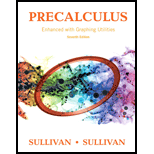
Concept explainers
Probability Suppose you attend a fundraiser where each person in attendance is given a ball, each with a different number. The balls are numbered 1 through . Each person in attendance places his or her ball in an urn. After dinner, a ball is chosen at random from the urn. The probability that your ball is selected is . Therefore, the probability that your ball is not chosen is . Graph using transformations. Comment on the likelihood of your ball not being chosen as increases.
Want to see the full answer?
Check out a sample textbook solution
Chapter 4 Solutions
Precalculus Enhanced with Graphing Utilities (7th Edition)
Additional Math Textbook Solutions
Introductory Statistics
Precalculus
Precalculus: A Unit Circle Approach (3rd Edition)
Elementary Statistics ( 3rd International Edition ) Isbn:9781260092561
Elementary Statistics Using The Ti-83/84 Plus Calculator, Books A La Carte Edition (5th Edition)
Elementary Statistics: A Step By Step Approach
- ints) A common representation of data uses matrices and vectors, so it is helpful to familiarize ourselves with linear algebra notation, as well as some simple operations. Define a vector ♬ to be a column vector. Then, the following properties hold: • cu with c some constant, is equal to a new vector where every element in cv is equal to the corresponding element in & multiplied by c. For example, 2 2 = ● √₁ + √2 is equal to a new vector with elements equal to the elementwise addition of ₁ and 2. For example, 問 2+4-6 = The above properties form our definition for a linear combination of vectors. √3 is a linear combination of √₁ and √2 if √3 = a√₁ + b√2, where a and b are some constants. Oftentimes, we stack column vectors to form a matrix. Define the column rank of a matrix A to be equal to the maximal number of linearly independent columns in A. A set of columns is linearly independent if no column can be written as a linear combination of any other column(s) within the set. If all…arrow_forwardThe graph of f(x) is given below. Select each true statement about the continuity of f(x) at x = 3. Select all that apply: 7 -6- 5 4 3 2 1- -7-6-5-4-3-2-1 1 2 3 4 5 6 7 +1 -2· 3. -4 -6- f(x) is not continuous at a = 3 because it is not defined at x = 3. ☐ f(x) is not continuous at a = - 3 because lim f(x) does not exist. 2-3 f(x) is not continuous at x = 3 because lim f(x) ‡ ƒ(3). →3 O f(x) is continuous at a = 3.arrow_forwardIs the function f(x) continuous at x = 1? (z) 6 5 4 3. 2 1 0 -10 -9 -7 -5 -2 -1 0 1 2 3 4 5 6 7 8 9 10 -1 -2 -3 -4 -5 -6 -7 Select the correct answer below: ○ The function f(x) is continuous at x = 1. ○ The right limit does not equal the left limit. Therefore, the function is not continuous. ○ The function f(x) is discontinuous at x = 1. ○ We cannot tell if the function is continuous or discontinuous.arrow_forward
- Is the function f(x) shown in the graph below continuous at x = −5? f(x) 7 6 5 4 2 1 0 -10 -9 -8 -7 -6 -5 -4 -3 -2 -1 0 1 2 3 4 5 6 7 8 9 10 -1 -2 -3 -4 -5 -6 -7 Select the correct answer below: The function f(x) is continuous. ○ The right limit exists. Therefore, the function is continuous. The left limit exists. Therefore, the function is continuous. The function f(x) is discontinuous. ○ We cannot tell if the function is continuous or discontinuous.arrow_forward4. Evaluate the following integrals. Show your work. a) -x b) f₁²x²/2 + x² dx c) fe³xdx d) [2 cos(5x) dx e) √ 35x6 3+5x7 dx 3 g) reve √ dt h) fx (x-5) 10 dx dt 1+12arrow_forwardMath 2 question. thxarrow_forward
- Please help on this Math 1arrow_forward2. (5 points) Let f(x) = = - - - x² − 3x+7. Find the local minimum and maximum point(s) of f(x), and write them in the form (a, b), specifying whether each point is a minimum or maximum. Coordinates should be kept in fractions. Additionally, provide in your answer if f(x) has an absolute minimum or maximum over its entire domain with their corresponding values. Otherwise, state that there is no absolute maximum or minimum. As a reminder, ∞ and -∞ are not considered absolute maxima and minima respectively.arrow_forwardLet h(x, y, z) = — In (x) — z y7-4z - y4 + 3x²z — e²xy ln(z) + 10y²z. (a) Holding all other variables constant, take the partial derivative of h(x, y, z) with respect to x, 2 h(x, y, z). მ (b) Holding all other variables constant, take the partial derivative of h(x, y, z) with respect to y, 2 h(x, y, z).arrow_forward
 Elementary AlgebraAlgebraISBN:9780998625713Author:Lynn Marecek, MaryAnne Anthony-SmithPublisher:OpenStax - Rice University
Elementary AlgebraAlgebraISBN:9780998625713Author:Lynn Marecek, MaryAnne Anthony-SmithPublisher:OpenStax - Rice University College Algebra (MindTap Course List)AlgebraISBN:9781305652231Author:R. David Gustafson, Jeff HughesPublisher:Cengage LearningAlgebra & Trigonometry with Analytic GeometryAlgebraISBN:9781133382119Author:SwokowskiPublisher:Cengage
College Algebra (MindTap Course List)AlgebraISBN:9781305652231Author:R. David Gustafson, Jeff HughesPublisher:Cengage LearningAlgebra & Trigonometry with Analytic GeometryAlgebraISBN:9781133382119Author:SwokowskiPublisher:Cengage Glencoe Algebra 1, Student Edition, 9780079039897...AlgebraISBN:9780079039897Author:CarterPublisher:McGraw Hill
Glencoe Algebra 1, Student Edition, 9780079039897...AlgebraISBN:9780079039897Author:CarterPublisher:McGraw Hill Algebra: Structure And Method, Book 1AlgebraISBN:9780395977224Author:Richard G. Brown, Mary P. Dolciani, Robert H. Sorgenfrey, William L. ColePublisher:McDougal Littell
Algebra: Structure And Method, Book 1AlgebraISBN:9780395977224Author:Richard G. Brown, Mary P. Dolciani, Robert H. Sorgenfrey, William L. ColePublisher:McDougal Littell Intermediate AlgebraAlgebraISBN:9781285195728Author:Jerome E. Kaufmann, Karen L. SchwittersPublisher:Cengage Learning
Intermediate AlgebraAlgebraISBN:9781285195728Author:Jerome E. Kaufmann, Karen L. SchwittersPublisher:Cengage Learning





